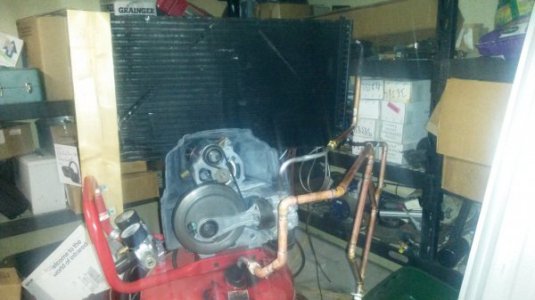Not *machinist* specific, but I'm sure most of us have a compressor at home and if you sand/soda blast, airbrush, or blow off things that you don't want to be rusty later, you could benefit from this...
I installed an "intercooler" on my compressor after I started soda blasting. This hot, humid SE TX air holds a lot of water, and something about being [compressed & heated] and subsequently [expanded and cooled] causes the water to separate out at the nozzle (I won't attempt to explain why, I suck at technical explanation and I'm not sure I fully understand it myself). So instead of "soda blasting" I was more "mud blasting."
I researched DIY solutions and most I found were along the lines of the "
Franzinator." But I didn't like those solutions because I didn't already have just a lot of large dia black Iron pipe laying around.
Also a lot of
these , which are mounted in walls/roof of your shop and therefore immobilize your compressor.
What I did have laying around was a used A/C condenser for my old pickup. I had replaced it because the bottom line where the orifice tube goes was bent. I mounted it on my compressor between the compressor head and the tank, that way it separates the water before it ever gets to the tank.

You can see in the pictures some black mess where the tubes come out of the compressor head and where they go into the tank. That is
Birchwood Casey Sight Black; I use it to get accurate temperatures with my Flir thermal imager. That's another shop tip, if you use a thermal imager or non-contact thermometer, they are calibrated to read temp off a flat black surface and don't read accurately on other surfaces, especially shiny surfaces. The Sight Black dries almost instantly, wipes right off (better with alcohol), and is a much better/cleaner alternative to spray painting things (although it does still make a bit of a mess).
The intercooler (confirmed by thermal imager) cools air coming out of the compressor from 350 deg F to 85 def F (ambient 83F) before entering the tank, without any cooling fan except the one already mounted on the compressor motor. The water falls to the bottom of the copper tube lattice where there is a bleed off valve. The compressor is still mobile (I use it outside a lot) as the cooler is mounted to the rolling unit and not to the shop wall.
As with most of "brilliant" ideas, I found out later that I was not the first; many have done it before me, and here's
an example.
 So there!
So there!

